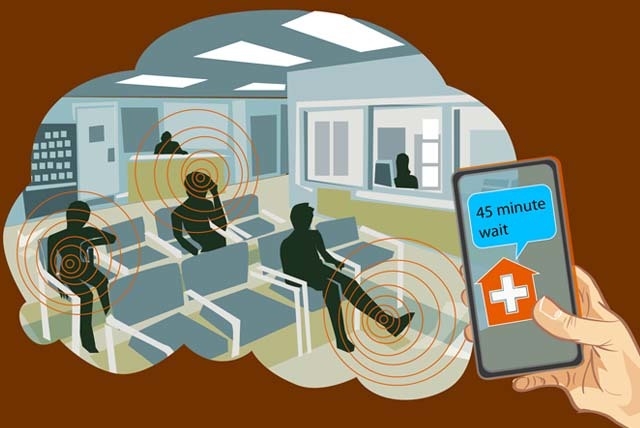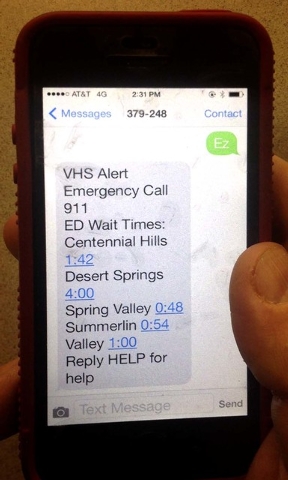Smartphone apps let patients gauge entry times for emergency rooms
It’s a beautiful Saturday afternoon, you’re at the park and decide to jump into a pickup basketball game with a group of guys about half your age.
As fast as you can say “bank shot” you’re on the ground clutching an ankle that feels like it was just steamrolled by a Land Rover. You grab your cellphone, type in “23000,” “ER,” your ZIP code, and in a couple of minutes a list of estimated wait times for three of the nearest hospital emergency rooms pops up on your screen.
Then, another text comes with a link to a medical application called iTriage. You log on and look up the symptoms for your injury, preregister with the nearest hospital and, with the tap of a finger, even signal that you’re on the way.
This scenario may seem far-fetched — not the injury, not the technology, but the idea that people can use their smartphones to get emergency-room wait times as if they were pulling up local movie listings. These are hospitals, after all, where lives are saved and medical miracles made.
Yet, the public now demands easily accessible information about nearly everything and this, of course, includes health care. Perhaps it was only a matter of time before emergency departments joined in.
Locally, the Sunrise Health System, which includes Sunrise, Sunrise Children’s, Southern Hills and MountainView hospitals, was the first to supply emergency-department wait times. The hospital group started posting and texting wait times in 2010, and soon followed with billboards that can be seen valleywide displaying estimated wait times for their closest emergency rooms.
Sunrise Health also gives patients the option of downloading iTriage — a mobile app providing information on everything from the nearest hospital’s location to details on specific diseases and medications — through its text messages. The app includes an iNotify prompt that lets patients check in with an emergency room and send notification that they are on their way.
During the past year, there have been about 2,000 check-ins within the hospital system via iNotify, said Brendan Bussmann, vice president of strategic development and marketing for Sunrise Hospital and Sunrise Children’s Hospital. The technology seems to be benefiting both locals and visitors, he added.
“I know that there are several people that will use it,” Bussmann said. “I know concierges within the hotels will use it, they’ll tell visitors that are coming in, part of our 40 million visitors that visit the Strip every year, that they can use that to figure out current wait times and check in through the iNotify process.”
The other major hospital groups now publish wait times online, too, but also allow patients without life-threatening conditions to make appointments for treatment times with the click of a mouse or the tap of a finger. This is primarily about providing a better experience for patients, hospital officials say.
“Let’s face it, patients aren’t happy when they’re not feeling well and have to sit in an ER for an extended period of time,” Dr. Maggie Rafferty, chief experience officer for Dignity Health-St. Rose Dominican, said in an email. “With this program we are able to keep those with nonemergent issues at home, where they’re comfortable.”
On a recent Thursday at about 4:30 p.m., InQuicker, the online reservation system for the three St. Rose Dominican hospitals, listed 5:30 p.m. as the next available treatment time for the San Martin and Rose de Lima campuses, with Siena following at 5:45 p.m.
A click on the preferred hospital brought up a short registration form requiring basic information such as name and email address and the reason for the visit. Rafferty said although InQuicker is meant to be used by those with minor conditions, the system backs this up by doing its own triage.
“All registrations are reviewed by a Dignity Health-St. Rose Dominican charge nurse upon initial notification,” Rafferty said. “If the patient’s condition warrants, the ER charge nurse calls/emails the patient to come to the ER immediately or dial 911. InQuicker does triage for emergent conditions and blocks the registration, keeping it blocked from registration attempts for 24 hours.”
While InQuicker was launched this past summer, Valley Health System started taking appointments online a little more than a year ago as part of its “ER Just Got Easier” initiative.
The reservation system, called ER Reserve, is accessible through the home page of each of the five hospitals’ websites — Desert Springs, Valley, Centennial Hills, Spring Valley and Summerlin hospitals. The sites explain that appointments can be made 12 hours in advance and are only for those with “non-life-threatening minor illnesses and injuries, such as: sore throat, earache, cough or cold, muscle strains and sprains.”
An appointment is made by providing basic information such as name and address, but a reason for the visit is not requested. Once the online form has been submitted, the information goes into the hospital’s computer system and the ER staff is alerted via smartphone, said Lori Harris, Valley Health System’s advertising director.
ER Reserve averages about 80 to 100 reservations every month between all five hospitals, Harris said. Valley Health also has a texting function so patients can get the latest wait times from their phones.
“So if you have a smartphone … you just text EZ to 379248 and instantly you have access to all five of the Valley Health System hospital wait times in the palm of your hand, or on your iPad or tablet or whatever mechanism you happen to be using,” Harris said.
Both hospital groups note on their websites that priority treatment always goes to those with the most urgent medical issues with or without an appointment. Also, as Rafferty points out, “patients (with appointments) don’t skip in front of other patients — they simply wait at home.”
Local hospital officials said wait times are approximate and, given the fluctuating nature of emergency rooms, can quickly change.
The idea that hospitals want to streamline care and improve patients’ experiences through slick mobile applications and scheduling systems doesn’t seem so outlandish.
The American College of Emergency Physicians reports that there are more emergency-room patients yet fewer emergency departments to take care of them given a shortage of inpatient beds and medical staff. During the 1990s, U.S. hospitals lost 103,000 staffed inpatient beds and 7,800 intensive-care beds. There is also expected to be a shortage of more than 24,000 physicians by 2020.
Emergency visit rates increased at twice the rate of growth of the U.S. population from 1997 to 2007, the ACEP stated. And, by law, emergency departments must treat all patients regardless of whether they’re insured or can pay out-of-pocket.
“Forever, the emergency department has been the safety net for everybody in this country,” said Alfred Sacchetti, an ACEP spokesman and an emergency physician at Our Lady of Lourdes Medical Center in Camden, N.J. “If you didn’t have insurance we took care of you. If you can’t get ahold of your doctor, we take care of you. If you don’t know whether you need a doctor or not, we take care of you. … Emergency physicians and emergency medicine in general is very proud of the fact that we’ve held that position.”
The Affordable Care Act is another question mark. Hospital officials don’t know yet whether more insured patients will mean more emergency room visits or more use of primary-care physicians.
But as hospitals proceed with this technology aimed at providing a closer link between patient and emergency room, there are issues to consider.
In 2012, the ACEP released a statement on the publishing of wait times, pointing out that it can serve as an effective marketing tool, “more evenly distribute” patients among a system’s hospitals, and push hospitals to improve their performance metrics based on patient wait times.
However, there is no national standard for estimated wait times. As the report states, “If we as providers are perplexed, what is the patients’ perception?”
In Las Vegas, for example, Valley Health defines wait time as the approximate average time it takes to be seen by a triage nurse, whose job it is to assess patients and prioritize based on who needs more immediate treatment.
St. Rose Domincan states on its website that it is how long it takes a patient to see a physician after arriving. Sunrise Health defines it as “the time from once they arrive to when greeted by a medical professional,” such as a physician, nurse practitioner or physician’s assistant, Bussmann said.
Other concerns noted in the report are that patients with serious conditions may delay getting care when they see extended wait times, or may choose hospitals that are farther away because of shorter posted wait times.
“Wait times are good if you truly do have a legitimate minor emergency. … The difficulty is, you’re asking, now, patients to make a decision: Do I have an emergency that I can go a great distance to get to a shorter wait, or do I have an emergency that I better get to the closest place even though I don’t know what their wait time is because I just need to get there?” Sacchetti said.
Sacchetti, whose hospital does not publish wait times or offer online appointments, said he is more concerned about appointment scheduling and the possibility it could put hospitals on shaky ground because of federal regulations such as the Emergency Medical Treatment and Labor Act, which governs equal access to emergency care.
But whatever the concerns, this is new territory and there will be kinks to work out. Sacchetti noted that the more educated patients become about their own health and how these online services work, the better.



















